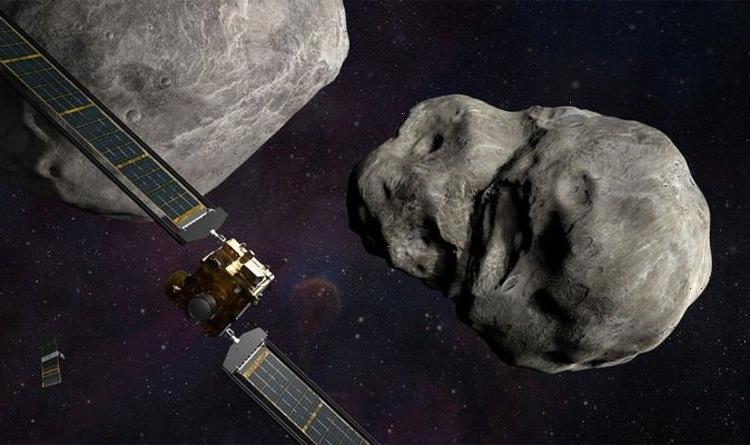NASA: OSIRIS-REx collects sample from asteroid Bennu’s surface
We use your sign-up to provide content in ways you’ve consented to and to improve our understanding of you. This may include adverts from us and 3rd parties based on our understanding. You can unsubscribe at any time. More info
The daring plan will see the US space agency launch a “kinetic impactor” into an asteroid to see whether it can be veered off course. NASA’s target is a binary asteroid system dubbed Didymos, which does not pose any danger to Earth but rather is the perfect candidate to test the technology. DART will target the smaller of the two asteroids, known as Didymoon, smashing into the space rock at speeds of about 6.6km per second or 14,760mph.
The mission is presently pencilled in for November 26 and the launch will be broadcast live online.
DART will blast off from the Vandenberg Space Force Base in California aboard a SpaceX Falcon 9 rocket.
Once launched, the NASA spacecraft will cruise towards Didymos for a rendezvous in late September next year.
By the time of arrival, the spacecraft and asteroids will be about 6.8 million miles (11 million km) from Earth.
The test is a proof-of-concept for NASA and scientist Thomas Statler said on NASA’s Houston, We Have a Podcast: “We’re going to make sure that a rock from space doesn’t send us back to the Stone Age.”


The impact test is expected to take place on October 2, 2022.
DART will fire its engines and crash into the 524ft-wide Didymoon while avoiding the bigger, 2,560ft-wide (780m) parent asteroid.
According to Dr Statler, the smaller asteroid “is more typical of the size of asteroid that could pose the most likely significant threat to Earth”.
But he noted Didymoon is “not necessarily the asteroid that’s going to cause a devastating effect on Earth.”
The test will slightly alter the asteroid’s path – not enough to send it careening off on a wild trajectory, but just enough for NASA to measure any change in its orbit.
The change should be big enough to be observed and measured by telescopes on Earth.
NASA highlight new asteroid threats to earth in US conference
If a worrisome asteroid is ever spotted heading directly towards our planet, scientists believe this will be the surest way to prevent an impact.
Even a fractional change in trajectory can make an asteroid miss by a large margin if struck early enough.
NASA said: “DART will be the first demonstration of the kinetic impactor technique, which involves sending one or more large, high-speed spacecraft into the path of an asteroid in space to change its motion.”
At present, there is no asteroid or comet that poses any danger to life on Earth.
But institutions like NASA and the European Space Agency (ESA) remain vigilant for any rogue space rock headed our way.
One small asteroid took the world by surprise in 2013 when it entered the skies over Russia’s Chelyabinsk Oblast.


The so-called Chelyabinsk meteor was missed as it entered from the direction of the Sun and proved fairly dangerous despite its small size – 65.5ft (20m) across.
Thankfully, the space rock exploded before it hit the ground as it was too small to survive the descent to Earth.
The resulting airblast, however, blew out windows in a large radius and injured more than 1,500 people.
NASA estimates the blast released the energy equivalent of about 440,000 tons of TNT.
Lindley Johnson, NASA’s Planetary Defense Officer, described the incident as a “cosmic wake-up call” to the dangers lurking in space.
He added: “We must keep looking for what we know is still out there to be found.”
Thousands of asteroids swing past our planet each year, many of which have been on NASA’s radars for decades.
Any object that approaches the Earth from less than 1.3 times the distance to the Sun is considered a “near-Earth object” or NEO.
However, NASA’s Asteroid Watch team noted: “Most NEOs pose no peril at all.”
Source: Read Full Article
